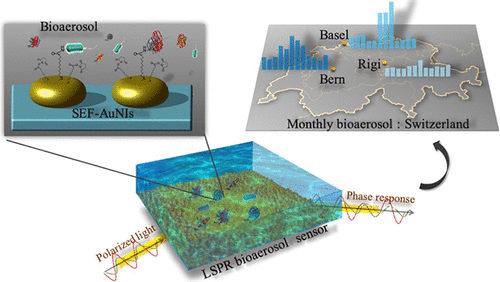当前位置:
X-MOL 学术
›
Environ. Sci. Technol.
›
论文详情
Our official English website, www.x-mol.net, welcomes your feedback! (Note: you will need to create a separate account there.)
Total Bioaerosol Detection by a Succinimidyl-Ester-Functionalized Plasmonic Biosensor To Reveal Different Characteristics at Three Locations in Switzerland.
Environmental Science & Technology ( IF 11.4 ) Pub Date : 2020-01-16 , DOI: 10.1021/acs.est.9b05184 Guangyu Qiu 1, 2 , Yang Yue 1, 2 , Jiukai Tang 1, 2 , Yi-Bo Zhao 1, 2 , Jing Wang 1, 2
Environmental Science & Technology ( IF 11.4 ) Pub Date : 2020-01-16 , DOI: 10.1021/acs.est.9b05184 Guangyu Qiu 1, 2 , Yang Yue 1, 2 , Jiukai Tang 1, 2 , Yi-Bo Zhao 1, 2 , Jing Wang 1, 2
Affiliation

|
Bioaerosols consisting of biologically originated airborne particles such as microbes, metabolites, toxins, and fragments of microorganisms are present ubiquitously in our living environment. The international interests in bioaerosols have rapidly increased because of their many potential health effects. Thus, accurate and fast detection of total bioaerosols in different environments has become an important task for safeguarding against biological threats and broadening the pool of bioaerosol knowledge. To quickly evaluate the total bioaerosol concentration, we developed a localized surface plasmon resonance biosensor based on succinimidyl-ester-functionalized gold nanoislands (SEF-AuNIs) for quantitative bioaerosol detection. The detection limit of our proposed SEF-AuNI sensors for model bacteria Escherichia coli and Bacillus subtilis can go to 0.5119 and 1.69 cells/mL, respectively. To demonstrate the capability of this bioaerosol sensing technique, we tested aerosol samples collected from Bern (urban station), Basel (suburban station), and Rigi mountain (rural and high altitude station) in Switzerland and further investigated the correlation with endotoxin and PM10. The results substantiated that our SEF-AuNI sensors could be a reliable candidate for total bioaerosol detection and air quality assessment.
中文翻译:

通过琥珀酰亚胺酯功能化的等离子生物传感器进行总生物气溶胶检测,以揭示瑞士三个位置的不同特征。
在我们的生活环境中普遍存在由生物起源的空气传播颗粒(例如微生物,代谢产物,毒素和微生物碎片)组成的生物气溶胶。由于生物气雾剂具有许多潜在的健康影响,因此国际上对它们的兴趣迅速增加。因此,准确,快速地检测不同环境中的总生物气溶胶已成为一项重要任务,可以保护生物免受威胁,并扩大生物气溶胶知识的范围。为了快速评估总生物气溶胶浓度,我们开发了一种基于琥珀酰亚胺酯功能化金纳米岛(SEF-AuNIs)的局部表面等离子体共振生物传感器,用于定量生物气溶胶检测。我们为模型细菌大肠杆菌和枯草芽孢杆菌提议的SEF-AuNI传感器的检测限可以达到0。5119和1.69细胞/ mL。为了证明这种生物气溶胶传感技术的功能,我们测试了从瑞士伯尔尼(城市站),巴塞尔(郊区站)和瑞吉山(农村和高海拔站)收集的气溶胶样品,并进一步调查了与内毒素和PM10的相关性。结果证实,我们的SEF-AuNI传感器可以作为总生物气溶胶检测和空气质量评估的可靠候选者。
更新日期:2020-01-17
中文翻译:

通过琥珀酰亚胺酯功能化的等离子生物传感器进行总生物气溶胶检测,以揭示瑞士三个位置的不同特征。
在我们的生活环境中普遍存在由生物起源的空气传播颗粒(例如微生物,代谢产物,毒素和微生物碎片)组成的生物气溶胶。由于生物气雾剂具有许多潜在的健康影响,因此国际上对它们的兴趣迅速增加。因此,准确,快速地检测不同环境中的总生物气溶胶已成为一项重要任务,可以保护生物免受威胁,并扩大生物气溶胶知识的范围。为了快速评估总生物气溶胶浓度,我们开发了一种基于琥珀酰亚胺酯功能化金纳米岛(SEF-AuNIs)的局部表面等离子体共振生物传感器,用于定量生物气溶胶检测。我们为模型细菌大肠杆菌和枯草芽孢杆菌提议的SEF-AuNI传感器的检测限可以达到0。5119和1.69细胞/ mL。为了证明这种生物气溶胶传感技术的功能,我们测试了从瑞士伯尔尼(城市站),巴塞尔(郊区站)和瑞吉山(农村和高海拔站)收集的气溶胶样品,并进一步调查了与内毒素和PM10的相关性。结果证实,我们的SEF-AuNI传感器可以作为总生物气溶胶检测和空气质量评估的可靠候选者。


























 京公网安备 11010802027423号
京公网安备 11010802027423号